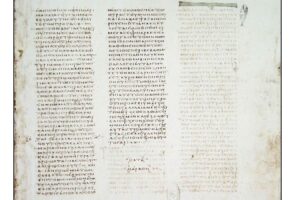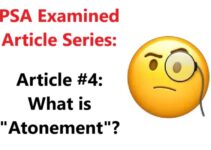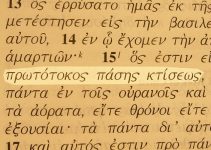
There’s a debate raging about whether Mark 16:9-20 was originally written by Mark, or if it was written latter and then added to Mark. Given that I have articles on the other two major textual variants (the Johannine Comma and the woman caught in adultery), I wanted to have one on the longer ending of Mark.
Thus I was gearing up for a very long and in-depth research project, when I discovered that a pastor/teacher that I greatly respect had already done a huge study. So I watched it. It was very complete, very thorough, and lined up perfectly with everything I’d already discovered.
Further, he was able to get access to some people/resources I would’ve had a near impossible time getting access to. In at least one case, those resources were decisive in their evidence.
Good stuff.
Thus instead of writing a long article, I’m going to embed his video below for your viewing pleasure. Fair warning: the video is about 2 hours and 10 minutes long because it’s very complete.
This video comes with my highest recommendation, with only one caveat: While I do definitely agree with his conclusion, I also definitely disagree on his short addendum. He admits right up front that it’s a strange addendum, and it is. I just needed to give that disclaimer. (The reason I reject his addendum is below the video, in expand/collapse text so I don’t spoiler the ending.)
Click Here to expand my thoughts on his addendum
Also, I highly recommend his follow-up video, which frankly is incredible. His conclusion is near iron-clad in my opinion, but it does leave some lingering questions. He does a great job of answering those lingering questions.
And that’s all for today folks. If you enjoyed those articles, you might also enjoy my articles on the Johannine Comma and the woman caught in adultery, and especially my article on textual criticism.




Have you considered the heptadic structure argument of the last 12 verses of Mark covered in depth by the late Chuck Missler?
https://www.khouse.org/articles/2000/201
It is very compelling to me as a fingerprint of God upon the passage and its inclusion.
Well, I went to the TR and just started by double checking the claims. According to MS word and several online character counters, those verses only have 166 words, not 175 like he claims. That’s not even divisible by 7, calling everything he said into question. So I wouldn’t say that’s evidence at all, or perhaps he’s using a different version of the TR.
I wonder if there was doubt with Erasmus, Tyndale, the 50 scholars of the KJV, Calvin and Beza? Calvin and Beza had the ‘Comma’ in half of their 16 or so manuscripts each. Did they doubt the Markan ending? hmmm
scholars doubt that John ch.21, 1&2 Timothy, Titus and 2 Thessalonians should be in the bible. They say that they are obvious later additions. The style and word usage are different than the authors. Perhaps the translators of the ESV will remove or bracket them!
James Snapp jr totally demolishes the idea that Mk 16, 9-20 is not found in early witnesses. He is looking for retractions from those who made those errors and are still taught today in colleges and footnotes in most bible versions today. (Metzker did make a retraction that few people know about). Snapps website is: “The text of the gospels.com”
I’m quite familiar with James Snapp and his work, and overall like it. However, he has a tendency to omit things that don’t support his position and also to omit things that chip away at his evidence. I’ve seen his work on the longer ending of Mark and it’s convincing, but if you look deeper you find out that a lot of what he says doesn’t necessarily mean what he says it means.
Good stuff, I really enjoy Pastor Mike Winger’s work and grudgingly came to the conclusion that this is in fact an addition. This has been the only time I have ever been primarily swayed by internal evidence (And Eusebius’ comment).
I would disagree with Pastor Mike that the Comma Johannine is in fact the third biggest (very probable) interpolation. I would instead, firmly give that title to Luke 22:43-44 “The agony in Gethsemane”
I also take more of a middle ground conclusion on the ending, between you and Pastor Winger. It still was included in the vast majority of our manuscripts and bibles since 400 and maybe that is divine providence. I can’t very comfortably say that God wants it in there. But I can’t comfortably omit it either. I’d put it somewhere along with the Pericope Adultarae and the Agony in Gethsemane somewhere in an appendix, either at the end of the Gospels or the New Testament.
I find it hard to believe that anyone would be ok with the lie that tells a new believer, “Hey, you can drink poison! It won’t hurt you.” as if tempting God would ever be sanctioned in His Holy Word. It’s a lie from hell and needs to be strongly called out for what it is.
Amen to that Joey F. Aramathea!
One issue is: do the signs in Mark 16:17-18 always follow each believer as an individual, or do they follow the collective body of believers occasionally? We’re familar with Acts 28:1-6 where Paul is bitten by a viper and shakes it into the fire.
Mali, Africa is the location of the city of Timbuktu (yes, it’s a real place!). I was inspired by an account I read that was written by Steve Saint, son of missionary pilot Nate Saint who was one of the five missionaries martyred by the Waodani tribe in Ecuador in 1956 (Elisabeth Elliot’s book “Through Gates of Splendor,” and the movie “End of the Spear”).
Steve Saint visited Timbuktu. At the time he was depressed and was wondering if his father had died in vain. There he met a young man who was forced to live on the outskirts of the city because he had been a Muslim who received Jesus. His family had put poison in his food. He ate it and nothing happened (Mark 16:17-18); his brother accidentally ate some of it and became paralyzed.
The young man told Steve Saint that he had been tremendously encouraged through his sufferings by a book he was reading about five missionaries who had been martyred in Ecuador in 1956. “What courage those missionaries must have had in that jungle!” he said. Steve Saint then had the privilege of telling the young man that the pilot had been his own father. They had some wonderful, faith-building fellowship. What a miracle these two men met, in Timbuktu of all places!
Another account of an ex-Muslim who miraculously survived poisoning by his family is the testimony of Mohammed (not the prophet of Islam but a young Fulani man in Nigeria). His testimony is dramatized at http://morethandreams.org/
Jason T, I find it ironic that Missler refers critically to Gnosticism before pursuing his own neo-Gnostic theory of numerology. He also mentions the early church father Irenaeus, who specifically warned against this type of fad in his work “Against Heresies.” He wrote that the Gnostics “endeavour to bring forward proof (of their system) through means of numbers, and the syllables of names, sometimes also through the letter of syllables, and yet again through those numbers, which are, according to the practice followed by the Greeks, contained in different letters: this I say, demonstrates in the clearest manner their overthrow and confusion, as well as the untenable and perverse character of their professed knowledge.”